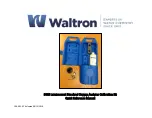
6 Troubleshooting Procedures
6.4.4 Inspecting Inside the Fluidics Module
If there is any chance at all that there could be fluid in the pipette tips, you must remove
the pipettor head from the instrument and dispel the fluid or remove the tips
outside
the
instrument. This must be done to avoid spilling fluid in the reading chamber.
Important!
Failure to dispel fluid outside the instrument may result in damage to the
optical components.
Biohazard
:
This procedure includes steps involving potentially infectious biological
agents requiring that proper handling precautions be taken. Follow your institution's
protocol.
1 Inspect the interior of the fluidics module.
Determine the position of the pipettor head and the location of all the tips that were
originally in the tip rack. Things to consider include:
•
Is the pipettor head loose? Is the red knob tightened securely?
•
Is the pipettor head up and out of the way (in home position) or is it down in the tip
rack area, the compounds plate area, or the reading chamber?
•
Are there any pipet tips on the pipettor head?
•
Is there is any chance there is liquid remaining in the tips? If so, remove the head and
expel the liquid safely. See procedures in sections 6.4.5, Removing the Pipettor Head,
and 6.4.6, Expelling Undispensed Fluid from Tips.
Caution:
Take care that you do not inadvertently dispel fluid before the pipettor head
is outside the instrument.
•
Can you account for all tips or is there a possibility that some have dropped out of
sight?
•
Do all the drawers move freely to gentle pressure or is there a plate or tip rack
jamming them?
Once you have determined the status of pipettor head and tips, there are a number of
procedure you may need to follow to resolve the problem. Possible scenarios include:
2 Pipettor head is in home position, without tips.
•
If the pipettor head is up and out of the way (without tips) but the tip rack is
jammed, it may be because one or more tips are not seated properly and are blocking
the drawer movement.
•
Reach into the fluidics module from the front panel and remove the tip rack by
lifting it up and out toward you. If the tip rack drawer is not all the way inside the
instrument (in its leftmost position), you may need to gently push it inside (to the
left) in order to get the rack out.
3 Pipettor head is in home position, without tips, but tips are missing.
•
If the pipettor head is up and out of the way (without tips) but there are tips missing
from the rack, then you must locate and recover the missing tips before proceeding.
•
Retrieve any tips you can easily see and reach through the front panel.
•
It may be necessary to raise the fluidics module, to gain access to the reading
chamber. See section 6.6, Tilting or Removing the Fluidics Module.
106
FlexStation II Operator’s Manual – Rev. D
Содержание FlexStation II
Страница 6: ...FlexStation II Operator s Manual Rev D vi ...
Страница 92: ...4 Applications 86 FlexStation II Operator s Manual Rev D ...
Страница 102: ...5 Service and Maintenance Procedures 96 FlexStation II Operator s Manual Rev D ...
Страница 124: ...6 Troubleshooting Procedures 118 FlexStation II Operator s Manual Rev D ...
Страница 134: ...7 Appendices 128 FlexStation II Operator s Manual Rev D ...
















































